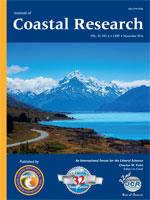Renjith, K.R.; Joseph, M.M.; Ratheesh Kumar, C.S.; Manju, M.N., and Chandramohanakumar, N., 2016. Nutrient distribution and bioavailability in a tropical microtidal estuary, southwest India.
This study estimates the spatial and seasonal variations of phosphorus and nitrogen fractions in the surface sediments of Cochin Estuary to assess their bioavailability and the factors governing biogeochemical distribution. Seasonal variations of the dissolved nutrients suggest that phosphorous buffering activity is very high in the estuary, and there could be a nitrogen limitation in the absence of any external input. Iron-bound and calcium-bound inorganic fractions were the major forms of sedimentary phosphorus in the central estuary. Upstream regions were characterised by higher proportions of organic phosphorus, mainly as alkali-soluble fractions. Bioavailable fractions ranged from 2.61% to 90.43% of total phosphorus and show a significant increase during the lean pre-monsoon period. This increase, which was not attributed to total phosphorus, could play a major role in negating any possible phosphorus limitation. The bioavailable nitrogen fractions varied from 1.57% to 23.89% of total nitrogen and were much lower when compared with phosphorus. Despite the concomitant increase in the water column as well as sedimentary nitrogen during the post-monsoon season, the seasonal variation was not reflected in the sedimentary bioavailable nitrogen percentage, as the increase was confined only to urea, which was found at negligible levels during the other seasons. The study showed that physical characteristics of the substratum play a major role in the geochemical distribution of nutrients, along with organic matter diagenesis. Higher heterotrophic activities fuelled by the allochthonous input of organic matter resulted in relatively lower retention of nitrogen in the sediments of Cochin Estuary.





